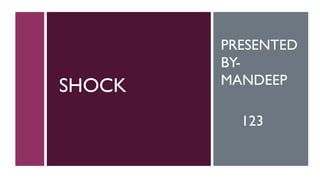
Presentation 4.pdf
- 2. CONTENTS Circulatory shock Types of shock Hypovolemic shock Relationship of bleeding volume to cardiac output and arterial pressure Sympathetic reflex compensations in shock Pathophysiology of shock Distributive shock Anaphylatic shock Septic shock Cardiogenic shock Obstructive shock
- 3. CIRCULATORY SHOCK Shock is a clinical syndrome characterised by inadequate blood flow to body tissue primarily due to low cardiac output.
- 4. TYPES OF SHOCK Hypovolemic –a cold shock Distributive orVasogenic or Low resistance or Warm shock Cardiogenic shock Obstructive shock
- 5. HYPOVOLEMIC SHOCK Clinical syndrome characterised by inadequate blood flow to body tissue due to low cardiac output . Failure of cardiovascular system
- 6. CHARACTERISTIC FEATURES OF HYPOVOLEMIC SHOCK Hypotension systolic blood pressure below 90 mmHg Rapid thready pulse Rapid shallow breathing Cold pale moist skin with greyish ting [cyanosis ] Intense thirst ADH and aldosterone release leads to decreased urine formation Lethargic and restless due to cerebral ischaemia
- 7. TYPES OF HYPOVOLEMIC SHOCK Hemorrhagics Traumatics Surgicals Dehydrations
- 8. HAEMORRHAGIC SHOCK haemorrhage Decreasecirculatory blood volume Decreased tissue perfusion Anaerobic respiration Increased lactic acid production (I) depress the myocardium(ii) decreaseperipheral vascular responsiveness to catecholamines Both leads to coma
- 9. RELATIONSHIP OF BLEEDINGVOLUME TO CARDIAC OUTPUT AND ARTERIAL PRESSURE shows the approximate effects on cardiac output and arterial pressure of removing blood from the circulatory system over a period of about 30 minutes. About 10 percent of the total blood volume can be removed with almost no effect on either arterial pressure or cardiac output, but greater blood loss usually diminishes the cardiac output first and later the arterial pressure, both of which fall to zero when about 40 to 45 percent of the total blood volume has been removed.
- 10. SYMPATHETIC REFLEX COMPENSATIONS IN SHOCK—THEIR SPECIALVALUETO MAINTAIN ARTERIAL PRESSURE The decrease in arterial pressure after hemorrhage,as well as decreases in pressures in the pulmonary arteries and veins in the thorax, cause powerful sympathetic reflexes initiated mainly by the arterial baroreceptors and other vascular stretch receptors These reflexes stimulate the sympathetic vasoconstrictor system in most tissues of the body, resulting in three important effects: • 1.The arterioles constrict in most parts of the systemic circulation, thereby increasing the total peripheral resistance. • 2.The veins and venous reservoirs constrict, thereby helping to maintain adequate venous return despite diminished blood volume. • 3. Heart activity increases markedly, sometimes increasing the heart rate from the normal value of 72 beats/min to as high as 160 to 180 beats/min.
- 11. PATHOPHYSIOLOGY OF HAEMORRHAGIC SHOCK RAPID COMPENSATORY REACTION LONGTERM COMPENSATORY REACTION
- 12. RAPID COMPENSATORY REACTION Haemorrhage Decreased blood volume Decreased venous return Decreased blood pressure Decreased cardiac output
- 13. Blood pressure sympathetic discharge Decrease baroreceptor activity Increase chemoreceptor activity ▪ Tachycardia ▪ Generalized vasoconstriction ▪ Stimulates respiration ▪ Renal vasoconstriction
- 14. LONG TERM COMPENSATORY REACTION Restoration of plasma of volume within 12-72 hours • By mobilization of tissue fluids • Retention of water and electrolytes by kidney Restoration of plasma protiens over a period of 3-4 days [because of activation liver] Restoration of RBC mass in 4 –8 weeks [because hypoxia leads to erythropoitin produced ] Restoration of blood pressure over several months via is kidney long term regulation
- 15. TRAUMATIC SHOCK Occurs due to injury causing severe damage to muscle and bone 1. Frank bleeding into injured areas results in shock. 2.If there is extensive soft tissue and muscle crushing (called Crush Syndrome), myoglobin leaks into circulation; it gets precipitated into renal tubules and clogs them resulting in renal damage.
- 17. SURGICAL SHOCK This occurs as a result of external or internal blood loss caused by ruptured blood vessels during surgical procedures.
- 18. DEHYDRATION SHOCK It occurs as a result of fluid loss from: (1) GIT due to prolonged vomiting or diarrhoea (2) Kidneys due to: (i) diabetes mellitus, (ii) diabetes insipidus, (iii) diuretic overdose, (iv) adrenal insufficiency. (3) Skin due to 'burns', heat stress (fever, exposure to heat) results in sweating. Shock due to burns is characterised with haemoconcentration
- 19. DISTRIBUTIVE SHOCK ❑Vasogenic shock ❑Low resistance shock ❑Size of capacitance vessel is increased by vasodilation leads to decreased cardiac output inspite of normal blood volume
- 20. DISTRIBUTIVE SHOCK INCLUDES................ Fainting /syncope • Sudden transient loss of consciousness due to decrease in cerebral blood flow • Also called as neurogenic shock • Associated with abrupt vasodilation but attack is short lived and consciousness is restored in few minutes ❑ Types 1. Vasovagal syncope –strong emotion causes vasodilation 2. Postural syncope- pooling of blood in dependent parts of body 3. Carotid sinus syncope –pressure on carotid sinus produced by tightcollars marked by bradycardia and hypotension
- 22. Anaphylactic shock • It is rapidly developing severe allergic shock • Occurs when an individual who has previously been sensitive to an antigen is re –exposed to it
- 23. SEPTIC SHOCK Certain infection eg strangulated bowel , perforated duodenum Release of bacterial endotoxin Absorbed into systemic circulation High fever and fall in blood pressure
- 25. MECHANISM OF DISTRIBUTIVE SHOCK • Genesis of antigen – antibody reaction • Release of large quantities of histamine Decrease in blood volume general arteriolar dilatation Increase in capillary permeability decrease in peripheral resistance Fall in blood pressure
- 26. CARDIOGENIC SHOCK It is caused when pumping action of the heart is inadequate ; therefore heart fails to pump out all venous return Marked decrease in cardiac output shock and congestion of lungs and viscera [congested shock] It can be caused by 1. MI 2. Arrythmia
- 27. OBSTRUCTIVE SHOCK Cardiac output is decreased as a result of mechanical obstruction of left or right ventricular filling Causes 1. Massive pulmonary embolism 2. Cardiac tamponade [bleeding into the pericardium with external pressure on the heart]